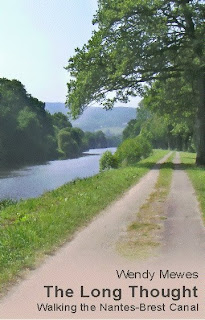A reporter from Ouest-France, the main daily paper here, accompanied a Morlaix town walk I guided last week. He was a young man who admitted he did not know the history of the town. All the more reason for him to listen? Not a chance, he's a journalist after all. The next day he sent me a PDF of the article - full of errors and misquotations, but I expect that after long experience of being interviewed by the French press. You accept these colourful diversions from the truth in return for publicity.
I was just about to file the article and think no more of it when I spotted the photo caption: there I am, on the bandstand in the Place des Otages, explaining the tragic fate of 60 Morlaisiens taken hostage and then transported like cattle to the death camps in reprisal for a resistance attack. What does the caption say - that I am describing the hostages being SHOT. Now not only is this a nasty slur on my reputation, but it is pretty unpleasant for the families of these poor men - Morlaix is a small town and this terrible event features large in many memories.
So I send an email at once to the journalist, Morgan Bourven. No reply. After brooding all weekend, I write a letter of complaint to the editors. Shortly after the journalist sends a brief email of apology and says a retraction will be published in the paper the following day. It isn't, so I write to him again, this time in anger. He replies blaming a secretarial error (!) and promises the text will appear tomorrow. Half an hour later he sends me the text to see if I approve. Frankly I think it is very little, but it includes a public apology to me as well as a correction of the facts, so I say OK.
Today, the retraction appears, but lo and behold! the apology has mysteriously disappeared and only a bald statement of fact remains. Anyone reading without significant attention might still have the impression that the mistake was mine. I am seriously upset by this - by their stupidity and ignorance in the first place (no-one in the Morlaix office of Ouest-France noticed such an appalling error before the paper went to press) and then the apparent play-acting that followed.
I think the best thing to do with Ouest-France in future is to stuff it in my walking boots to help the drying process.
POSTSCRIPT I have just received a message from the journalist saying that it is an 'apology to history not to Wendy Mewes' - there you are, folks - NOW they care about history, but they don't give a shit about my professional reputation. If I was French it would be a very different story.............. but at least this shows them in their true light.
ADDENDUM: after reading Laurent's comment and receiving another message from the journalist, let me say that he, Morgan Bourven, tried to do the right thing but was overruled by more senior staff who did not feel I was important enough to merit an apology.
.JPG) Today was the first outing for my superb new walking boots, which arrived yesterday after a nightmare of searching, ordering, being told that 'in stock' actually means arriving in February, or that my feet are unreasonably small and therefore not 'normally' catered for. England is clearly increasingly full of cart-horses. Thanks to the efficient and good-humoured staff at Cave and Crag (http://www.cave-crag.co.uk/ - thanks, Dave :-)) who rushed out a pair within hours of my plea, the great day is here and what a walk I had on the soupy, sloppy December moors, with dry and warm feet.
Today was the first outing for my superb new walking boots, which arrived yesterday after a nightmare of searching, ordering, being told that 'in stock' actually means arriving in February, or that my feet are unreasonably small and therefore not 'normally' catered for. England is clearly increasingly full of cart-horses. Thanks to the efficient and good-humoured staff at Cave and Crag (http://www.cave-crag.co.uk/ - thanks, Dave :-)) who rushed out a pair within hours of my plea, the great day is here and what a walk I had on the soupy, sloppy December moors, with dry and warm feet.
































